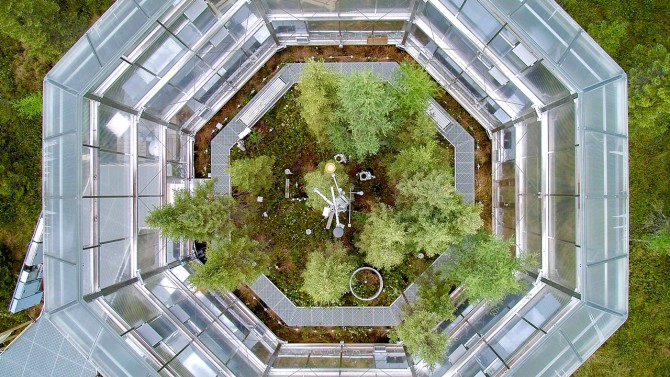Peatlands make up just 3% of the earth's land surface but store more than 30% of the world's soil carbon, preserving organic matter and sequestering its carbon for tens of thousands of years. A new study sounds the alarm that an extreme drought event could quadruple peatland carbon loss in a warming climate.
In the study, published Oct. 23 in Science, researchers find that, under conditions that mimic a future climate (with warmer temperatures and elevated carbon dioxide), extreme drought dramatically increases the release of carbon in peatlands by nearly three times. This means that droughts in future climate conditions could turn a valuable carbon sink into a carbon source, erasing between 90 and 250 years of carbon stores in a matter of months.
Inside peatlands test chambers at an experimental site in northern Minnesota, researchers could manipulate the temperatures, as well as the levels of carbon dioxide.
"As temperatures increase, drought events become more frequent and severe, making peatlands more vulnerable than before," said Yiqi Luo, senior author and the Liberty Hyde Bailey Professor in the School of Integrative Plant Science's Soil and Crop Sciences Section, in the College of Agriculture and Life Sciences (CALS). "We add new evidence to show that with peatlands, the stakes are high. We observed that these extreme drought events can wipe out hundreds of years of accumulated carbon, so this has a huge implication."
It was already well-established that drought reduces ecosystem productivity and increases carbon release in peatlands, but this study is the first to examine how that carbon loss is exacerbated as the planet warms and more carbon dioxide enters the atmosphere. The Intergovernmental Panel on Climate Change estimates extreme drought will become 1.7 to 7.2 times more likely in the near future. With that probability, Luo said the study's results are another warning about the dire impacts of global warming and a call to pay more attention to peatlands, despite their small geographical footprint.
"It's a huge reservoir of carbon compared to any other ecosystem," he said. "We need to find a way to mitigate climate change and bend the warming curve."
Luo and his team, including first author and postdoctoral researcher Quan Quan, used data from a field experiment in a natural boreal spruce bog in northern Minnesota, which housed 10, 20-meter-wide, yurt-like test chambers. Inside the chambers, researchers were able to manipulate the temperatures, as well as the levels of carbon dioxide.
This study focused on peatland carbon loss during an extreme drought event in July and August of 2021, under 10 future climate change scenarios at the experimental site. The researchers found that the lowered water table during drought took longer to recover at higher temperatures and elevated carbon dioxide levels, which led to more carbon release.
Luo expected that warmer temperatures would cause more carbon loss during drought, but the impact of elevated carbon dioxide - the fact that it also exacerbates carbon loss - was surprising. Increased levels of carbon dioxide in "uplands," areas at higher elevation than peatland bogs or wetlands, can actually stimulate photosynthesis and improve plants' water-use efficiency, partly mitigating the impacts of extreme drought.
"Previous studies indicated that elevated carbon dioxide can usually make extreme events less impactful, but our results indicate the opposite," Luo said.
In peatlands, the team found that elevated carbon dioxide alone, without elevated temperatures, did improve ecosystem productivity. But with both increased temperatures of 9 degrees Celsius and elevated carbon dioxide levels, the authors write that there was a "dramatic" increase in carbon emissions during the 2021 drought.
Quan dug into the data and found that elevated carbon dioxide levels increased the amount of substrate and dissolved carbon in the bog. When that dissolved carbon is exposed to oxygen under drought, more carbon dioxide is released into the atmosphere.
Since 2015, Luo has been a part of a team of 250 researchers who worked at the experimental site, and his team's role has been to integrate the data collected with models to better understand how the peatlands respond to environmental changes.
Other co-authors include postdoctoral researchers Jian Zhou and Ning Wei; senior research associate Lifen Jiang; and researchers from Florida State University, the U.S. Department of Agriculture (USDA), Georgia Institute of Technology, ETH Zurich, Northern Arizona University, the Australian National University, the University of Western Ontario and Duke University.
Funding for the study came in part from the National Science Foundation, USDA, the U.S. Department of Energy's Office of Biological and Environmental Research, the New York State Department of Environmental Conservation and the New York State Department of Agriculture and Markets.







